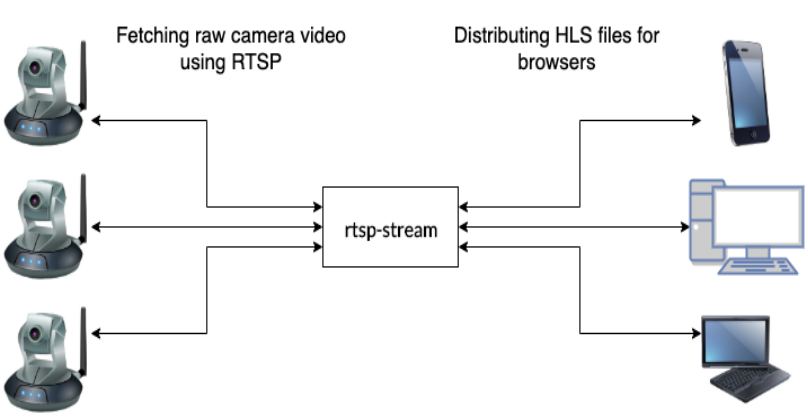An RTSP camera works by converting visual data into electronic signals. It streams this data over a network using the Real-Time Streaming Protocol (RTSP), allowing you to control and view the footage remotely. The camera uses sensors like CMOS or CCD to capture high-quality images, often compressing the video to guarantee efficient transmission without losing too much quality. This streaming process involves requesting the stream, transmitting the data, and then displaying it on your device. These cameras are perfect for applications like home security and live event broadcasting. Want to discover more about its detailed process?
Basics of RTSP

At its core, RTSP (Real-Time Streaming Protocol) is a network control protocol designed for use in entertainment and communications systems to control streaming media servers. Imagine you’re exploring for more control over your media streams. RTSP offers you just that by using a straightforward protocol structure which lets you control playback, pause, and record functions remotely.
When you immerse yourself in RTSP, you’ll find that it thrives on client-server interaction. The client, which can be software on your device, sends requests to the server, which holds the media. It’s like having a conversation. The client asks, “Can I play this video?” and the server responds with either a yes or no, or even more detailed instructions. This back-and-forth ensures that you can stream your media seamlessly without interruptions.
You’re not tied down by complicated setups or rigid systems; the beauty of RTSP lies in its flexibility and ease of use. Its protocol structure is designed to be simple yet powerful, giving you the freedom to interact with your media in a way that suits you best. It’s all about providing you with control, without the hassle.
How RTSP Cameras Capture Footage
When an RTSP camera captures footage, it uses a built-in image sensor to convert light into electronic signals that form a video stream. The quality of the footage largely depends on the type of sensor and lens selection. You’ve got a couple of sensor types to choose from: CMOS (Complementary Metal-Oxide-Semiconductor) and CCD (Charge-Coupled Device). Each sensor type has its perks. CMOS sensors are popular because they’re energy-efficient and offer high-speed performance. On the other hand, CCD sensors are known for their excellent image quality and light sensitivity, making them ideal for low-light conditions.
Choosing the right lens is equally important. The lens selection can dramatically impact the field of view, focus, and depth of the footage. Wide-angle lenses are great for capturing broad scenes, while telephoto lenses let you zoom in on distant objects without losing detail.
Video Compression Techniques
To efficiently transmit video over networks, RTSP cameras rely on various video compression techniques. These methods are important in reducing file sizes without compromising quality, giving you the freedom to stream high-quality video without hogging your bandwidth.
There are two main types of compression: lossless and lossy. Lossless compression retains all original data, guaranteeing no quality is sacrificed. However, it’s less efficient in reducing file size. On the other hand, lossy compression, which includes various MPEG standards, balances quality and efficiency by discarding some data that’s less perceptible to the human eye.
Here’s a quick look at the differences:
| Compression Type | Data Retention | Use Case Example |
|---|---|---|
| Lossless | All data kept | Archival footage |
| MPEG-1 | Moderate loss | VCD quality |
| MPEG-2 | Moderate loss | DVDs, TV Broadcasts |
| MPEG-4 | Higher efficiency | Online streaming |
MPEG standards, like MPEG-4, are particularly popular because they offer high compression ratios with minimal quality loss, making them perfect for streaming. By leveraging these techniques, RTSP cameras ensure you get a seamless, high-quality viewing experience without excessive data usage. So, you can enjoy the freedom of reliable, crisp video, anytime, anywhere.
Streaming Over Networks
While video compression guarantees efficient data transmission, streaming over networks is the process that delivers this compressed video to your device in real time. This is where network protocols come into play, ensuring the seamless delivery of video streams. RTSP (Real-Time Streaming Protocol) is the backbone, orchestrating how your device requests and receives streams. It’s all about freedom in accessing live footage whenever and wherever you are.
However, streaming isn’t without its challenges. Latency issues can disrupt the experience, causing delays that might make the live feed less “live.” Imagine waiting for critical security footage and encountering a lag—that’s the last thing you want. To mitigate these issues, robust network protocols are essential. Here’s a glimpse of how it works:
- Requesting the Stream: Your device sends a request through RTSP to the camera, asking for a stream.
- Transmitting Data: The camera sends compressed video data over the network using efficient protocols like RTP (Real-Time Protocol).
- Receiving and Displaying: Your device then decodes and displays the video, ideally with minimal delay.
Applications of RTSP Cameras
RTSP cameras find widespread use in various applications, from home security systems to live event broadcasting. If you value freedom and flexibility, you’ll appreciate how RTSP cameras empower you with remote monitoring capabilities. Whether you’re halfway around the world or just around the corner, you can keep an eye on your home, your business, or any other property directly from your smartphone or computer.
In the domain of security systems, RTSP cameras are a game-changer. Traditional security measures often tie you down with bulky equipment and complex setups. But with RTSP cameras, you get seamless integration and easy access. Imagine being able to check live footage of your home or office anytime, anywhere. That’s the kind of liberty RTSP technology brings to the table.
For those who love capturing and sharing live events, RTSP cameras offer unparalleled versatility. Whether you’re broadcasting a concert, a sports game, or even a family gathering, RTSP cameras provide a reliable and high-quality streaming solution. You can deliver real-time experiences to your audience without the hassle of complicated setups, ensuring you never miss a moment.
Frequently Asked Questions
What Are the Common Security Risks Associated With RTSP Cameras?
Imagine a ticking time bomb: using RTSP cameras with firmware vulnerabilities or default passwords can expose you to hackers. Guard your freedom by updating firmware and setting strong passwords to protect against these common security risks.
Can RTSP Cameras Be Integrated With Home Automation Systems?
Absolutely, you can integrate RTSP cameras with home automation systems. Their smart integrations and automation compatibility offer you the freedom to monitor and manage your home seamlessly, enhancing both convenience and security.
How Do RTSP Cameras Handle Low-Light Conditions?
When the sun takes its nightly nap, RTSP cameras don’t skip a beat. They use infrared illumination and advanced image processing to guarantee you get clear visuals, maintaining your sense of freedom and security intact.
What Is the Typical Lifespan of an RTSP Camera?
You’re wondering about camera longevity? Typically, an RTSP camera lasts 5-10 years. Regular maintenance frequency is key to maximizing its lifespan. With proper care, you’ll enjoy the freedom of long-term, reliable surveillance without constant replacements.
Are There Any Licensing Fees for Using RTSP Technology?
You’re in luck! There are no colossal licensing costs or royalty fees to worry about when using RTSP technology. It’s designed with freedom in mind, allowing you to stream without being bogged down by extra expenses.



